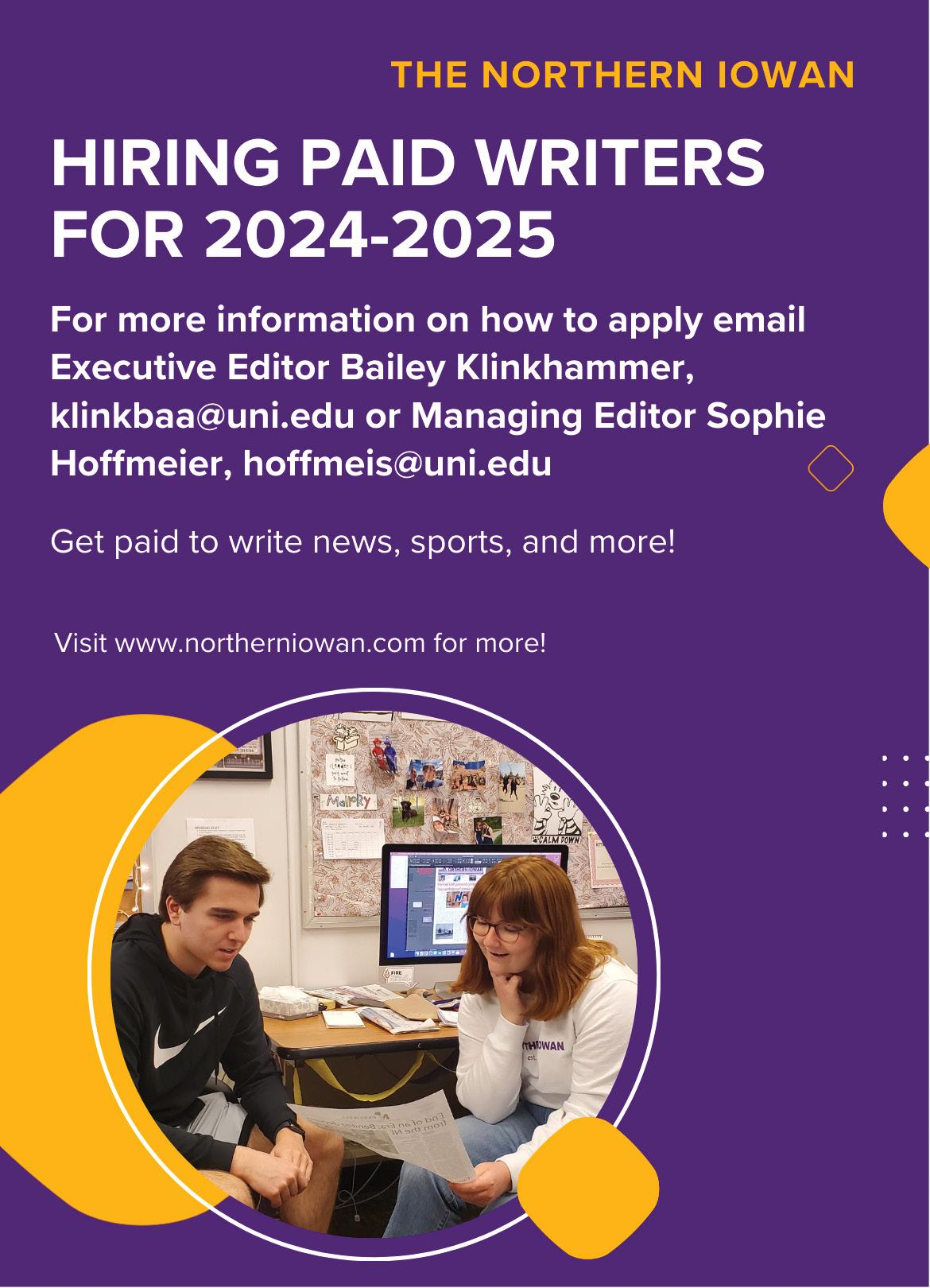
CEDAR FALLS, IA
WEDNESDAY, SEPTEMBER 4, 2024
VOLUME 121, ISSUE 2




CEDAR FALLS, IA
WEDNESDAY, SEPTEMBER 4, 2024
VOLUME 121, ISSUE 2


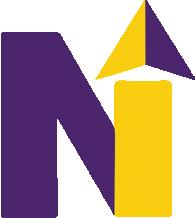
SOPHIE HOFFMEIER Managing Editor

The Northern Iowan sat down with President Mark Nook to follow up on his ideas from 2023, and how the university plans to expand upon these ideas into 2025.
What do you miss the most in May when campus empties out and students go home for the summer?
“There’s a couple days in the first few weeks after students leave, and that’s some of my favorite time on campus, right? Because it’s a chance for those of us that work here to just kind of take a breath and start to think about everything that’s happened over the past year and start to think about what the next year will be like. So there’s this sort of restful period as we just all kind of unwind from the hecticness that is the end of the semester. But after those initial first two weeks, it’s like, this is a campus. There’s supposed to be students here.
NORTHERN IOWAN
L011 Maucker Union Cedar Falls, IA 50614 www.northerniowan.com northern-iowan@uni.edu 319.273.2157
BAILEY KLINKHAMMER Executive Editor klinkbaa@uni.edu 563.321.1640
SOPHIE HOFFMEIER Managing Editor hoffmeis@uni.edu 515.795.6066
One of the things I miss is as I walk around campus, of course, I’m always running into students, oftentimes students I know or that know me, and just having these casual conversations. Those happen all the time, but over the summer, there’s fewer of them. So it’s still a very enjoyable place, but it’s very different without students and I definitely miss the daily interactions with students a great deal.”
What was one of the highlights of your summer?
“My wife and I went to Alaska for our vacation. So we spent eight days riding the rails in Alaska. We didn’t go out along the coast or fishing or anything like that. We flew into Anchorage, and then took the train up to Denali and on up to Anchorage, Fairbank and took a charter flight up north of the Arctic Circle. That was a big, big highlight.”
Coming into this school year, what are you anticipating the most?
EDITORIAL STAFF JO BRAHMS News Editor brahmsj@uni.edu
ESTELLE JOHNSON Campus Life Editor johnsecr@uni.edu
COHEN KAMAUS Sports Editor kamausc@uni.edu
ANTONIA GOODWIN Copy Editor goodwaab@uni.edu
LUIS ALVAREZ Spanish Editor alvarlaa@uni.edu
Revisiting your interview with Caroline Christensen, the former Northern Iowan Executive Editor, you discussed how the new nursing program and applied engineering building are in the works. A year later, where are those projects today?
“Well, looking back a year later, those projects are kind of coming to fruition. We’re welcoming our first cohort of nursing students into the new facility. We’re also welcoming our first students in the material science engineering program, and those facilities that you mentioned are important. It really is phenomenal what facilities has been able to do to lay that space out and make it work, bring in all the equipment from the beds to the apparatus and the mannequins, it’s really all been amazing to see.”
“One of the things that is already going really well is the Our Tomorrow campaign, in raising funds to support students, to support faculty and staff. I’m kind of hoping that during this year we reach our goal of $300 million about a year early, and we’ll continue to blow by that goal. But this year to actually reach that goal, that’ll be a big thing because of what it means to support our students and faculty, and we’ll be able to increase the educational opportunities for students. That’s what this campaign is all about. On top of that, there’s a host of exciting things happening locally and nationally, especially with the presidential election that is going on. I always look forward to working directly with NISG and with Lizbeth Montalvo this year as the (student body) president. We’re both excited, you know, figuring out where they want to go with some student things, or understanding what we’re trying to do as a university, and working together to make that happen.”
PRODUCTION STAFF
SOPHIE HOFFMEIER Webmaster
LIZBETH GARCIA TELLEZ Social Media Manager garcilaj@uni.edu
With DEI being restructured across regent Iowa campuses, how is DEI changing at UNI and how is inclusion being integrated into UNI as an institution?
“As the board of regents wrestled with this, as the state legislature wrestled with this, the one thing that we wanted as a university is to stay committed to our students, and that will never change. Since 149 years ago when UNI opened its doors, we’re here to support every single student and make sure that every single student has the tools they need to be successful. We have a moral obligation to be able to support them and help them get the education they need. We won’t ever back away from that. It’s taken a sort of adjustment, and that’s to be expected. We’ve had to shuffle some things to be in line with what’s required of us from the board of regents and the legislature, but we’re making sure that at the end of the day, we’re still serving the needs of our students and
faculty. That’s something that could never change.”
You have a Ph.D. in astronomy and you’re the president of a university with more programs than I could count, what programs here intrigue you the most? If you could follow a student around for the day, what kind of programs would you want to explore?
“That’s really hard! I don’t know if I could pick just one. I really love watching what the theater program does every year. It would be really fun to sit in on a couple of those classes. I’d love to see what the music students do as well, sit in on those classes. The gerontology program, especially with the dementia simulation house, that would be just so cool to see, too. There’s so many programs here that are so interesting but spending my own time as a student studying sciences, I would love to see the different art programs.”
What’s one piece of advice you wish you could tell each student when they graduate from UNI?
“It probably changes every time somebody asks me, but I think one of the things I would like to tell everybody, and one thing I tell my kids, is spend some real time thinking about the investment you want to make with your life. You’ve got the education you need to move into a career. You’ve got a relatively short time here, how do you want to use that time to invest in yourself and others? What portion to your career, what portion to your family, what portion to your community? What are the things that are important to you, and then figure out your purpose; and your purpose can change, but set a strong moral compass. What’s your North Star?”
LETTERS TO THE EDITOR
Letters must be less than 300 words in length and are subject to editing. Not all submissions will be printed. Send submissions to northern-iowan@uni.edu.
ANELIA DIMITROVA anelia.dimitrova@uni.edu
CHRIS MARTIN christopher.martin@uni.edu
CIRCULATION
BETHANY WINGET
Circulation Manager ADVISERS
The Northern Iowan is published weekly on Wednesday during the academic year, except for holidays and examination periods, by the University of Northern Iowa, L011 Maucker Union, Cedar Falls, IA 50614-0166 under the auspices of the Board of Student Publications. Advertising errors that are the fault of the Northern Iowan will be corrected at no cost to the advertiser only if the Northern Iowan office is notified within seven days of the original publication. Publisher reserves the right to refuse any advertisement at any time.
The Northern Iowan is funded in part with student activity fees.
All material is © 2024 by the Northern Iowan and may not be used without permission.
SEND US STORY IDEAS Tell us what’s happening on campus. Email submissions to northern-iowan@uni.edu.
Do you want to have an event listed here? Email us at northern-iowan@uni.edu with information about the event to have it featured.

JO BRAHMS News Editor
With campus buzzing back to life after the summer months, many new students are looking for the perfect organization to join. For some of those students, their perfect organization is a chapter in sorority life. Primary recruitment starts
to know people in the community. So it’s just a set of events where you get to go and meet women from every single chapter. You get to know them based on who they are, what they value, what they like to do and it just allows you to connect with people that are like you.” explains Laura Harms, a senior at UNI, an active
ple within the community within your specific chapter which is a really great opportunity. And then, afterwards, if you were to receive a bid, then you join your respective chapter and you’re able to make connections within that chapter, but then you’re also now open to an entire community of women on campus”
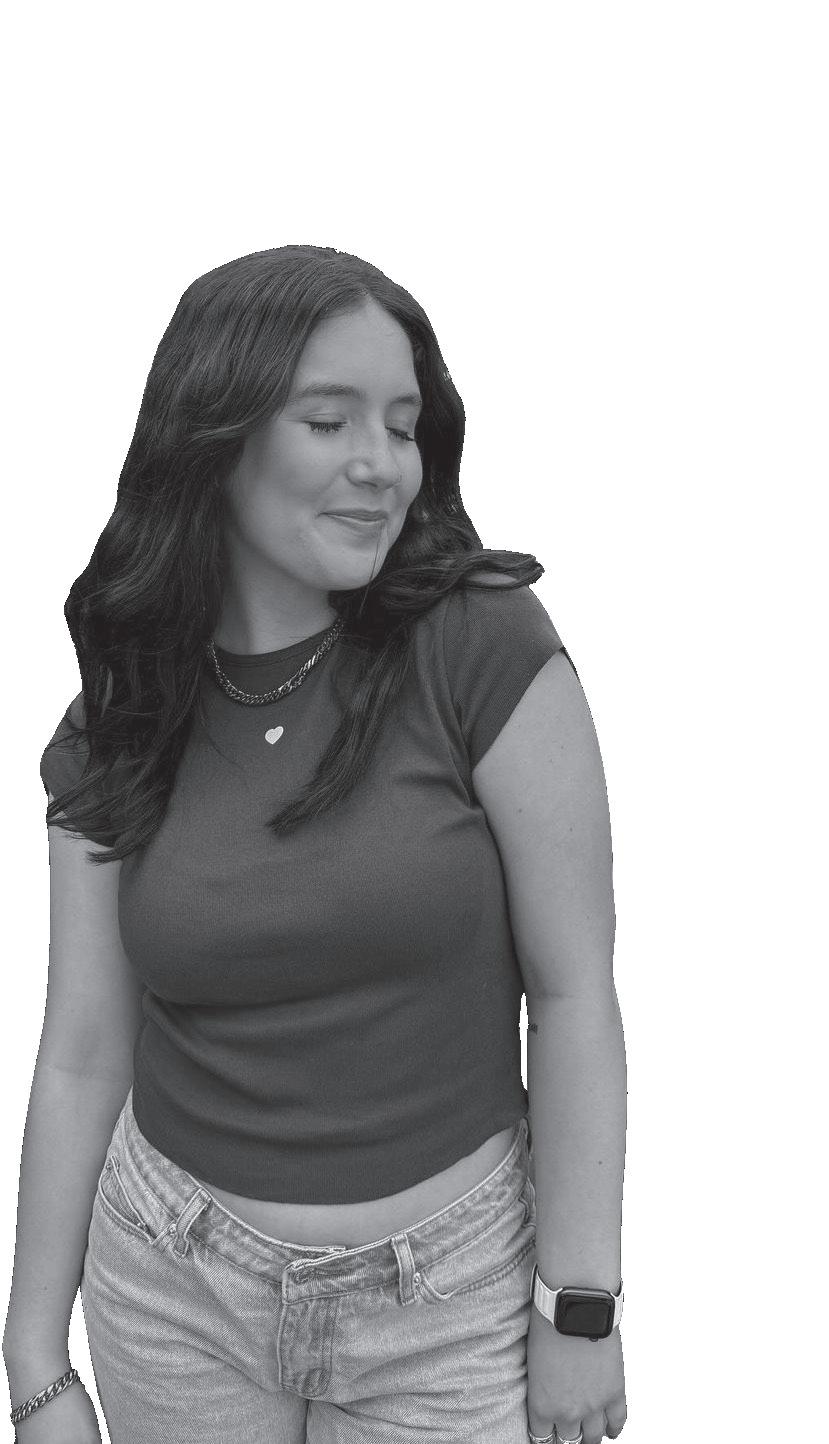
viduals graduated during COVID, and now we’re getting to the point where new people were not here during COVID, so we started from the ground up over the last two years. We are having to teach individuals all of the great things that we can do that we were previously doing. So, tying all of this back into the increase in interest, we’ve built that experience again so we can share all the things that make our community great on campus.”
The UNI sororities are excited to see such a sharp increase of interest in their organization. Harms explained that this renewed increase of interest isn’t just lucky, but rather a payoff after a long campaign from the 23-24 Panhellenic coun -
“I served as Co-VP of Recruitment last year with Cassie Williams and it was such a great experience for us, because we were able to kind of lay the foundation for stuff going forward. So we’ve done a lot more outreach in the last few years, and that does not come from one person; that comes from our entire group and all of last year’s work. It also comes from the continued work of the recruitment guides this year. So I don’t think it’s necessarily “lucky” but I think between all that work and with our advisor, Josh Farris, we were set up for success this year. He’s giving us the resources, he’s finding them for us. We’ve chosen to use them and we’re working to become a name on campus that people know.”
It’s not just the increase of outreach from the Panhellenic council that created this interest. Farris also said that many new panthers are looking for more “intentional interactions.” He explained this sentiment further, “I think today’s college students are looking for opportunities to grow and develop outside of the classroom. I think they’re also looking for a strong sense of just connection and belonging on campus. That can look different for everyone for what makes them feel like they belong but I think Sorority Life on UNI’s campus gives an opportunity for everyone to at least explore. Maybe not everybody’s gonna join and
that’s totally fine but it gives them the opportunity to say ‘What is this? Can I find my people here?’”
This group isn’t losing steam; they have high expectations for the coming years. When Farris was asked what a freshman entering primary recruitment this year could expect the community to look like by the time they are a senior, he said, “Last fall semester we grew from the start of the fall semester to the end of fall semester the sorority community group by 55%. They had 100 members to start and then 55 joined, so 55% increase. We’re looking to continue that trend and if you continue that trend over a four-year span the community grows exponentially. When there’s more people in the community that are proud of the community and are enjoying it it’s easier to tell more people about the community because you have more people doing the outreach and sharing their experience of why it’s impactful and valuable to them.”
When it comes to primary recruitment, Harms says be yourself, you never know just how far Sorority Life can take you. She went further stating that before joining Alpha Phi, she didn’t even know what her major was. “I’ll never get tired of talking about this! In high school I was always very involved. I was always seeking out leadership opportunities. My band director at the time really pushed me to look into bigger leadership roles and so when I came to UNI I was immediately like, ‘What am I gonna do? I’m a leader, I want to be a leader, how am I gonna get involved in that?’ Sorority Life provided the perfect pipeline for me to get involved. It set me up for success, it got me leadership opportunities, got me leadership experience and just allowed me to network a lot more. Ithelped me find my major; I didn’t know what I wanted to do when I came to UNI. Honestly it has really set me up for success in the future.

BAILEY KLINKHAMMER Editora Ejecutiva LUIS ALVAREZ Editor de español
El Northern Iowan se reunió con el presidente Mark Nook para dar seguimiento a sus ideas de 2023 y cómo la universidad planea expandir estas ideas hasta el 2025.
¿Qué es lo que más extraña en mayo cuando el campus se vacía y los estudiantes se van a casa para el verano?
“Hay un par de días en las primeras semanas después de que los estudiantes se van, y esos son algunos de mis momentos favoritos en el campus, ¿verdad? Porque es una oportunidad para que los que trabajamos aquí podamos tomar un respiro y empezar a reflexionar sobre todo lo que ha sucedido durante el año anterior y pensar en cómo será el próximo año. Así que hay un período de descanso mientras todos nos relajamos del ajetreo que es el final del semestre. Pero después de esas primeras dos semanas, es como, esto es un campus. Se supone que debe haber estudiantes aquí. Una de las cosas que extraño es que mientras camino por el campus, por supuesto, siempre me encuentro con estudiantes, a menudo estudiantes que conozco o que me conocen, y tener estas conversaciones casuales. Eso sucede todo el tiempo, pero durante el verano, hay menos de ellas. Así que sigue siendo un lugar muy agradable, pero es muy diferente sin estudiantes y definitivamente extraño mucho las interacciones diarias con los estudiantes.”
¿Cuál fue uno de los momentos más destacados de su verano?
“Mi esposa y yo fuimos a Alaska para nuestras vacaciones. Pasamos ocho días recorriendo Alaska en tren. No fuimos a la costa ni a pescar ni nada de eso. Fuimos en avión a Anchorage, y luego tomamos el tren hasta Denali y luego hasta Anchorage, Fairbank y tomamos un vuelo chárter al norte del Círculo Ártico. Eso fue un gran, gran momento destacado.”
Al comenzar este año escolar, ¿qúe es lo que más le ilusiona?
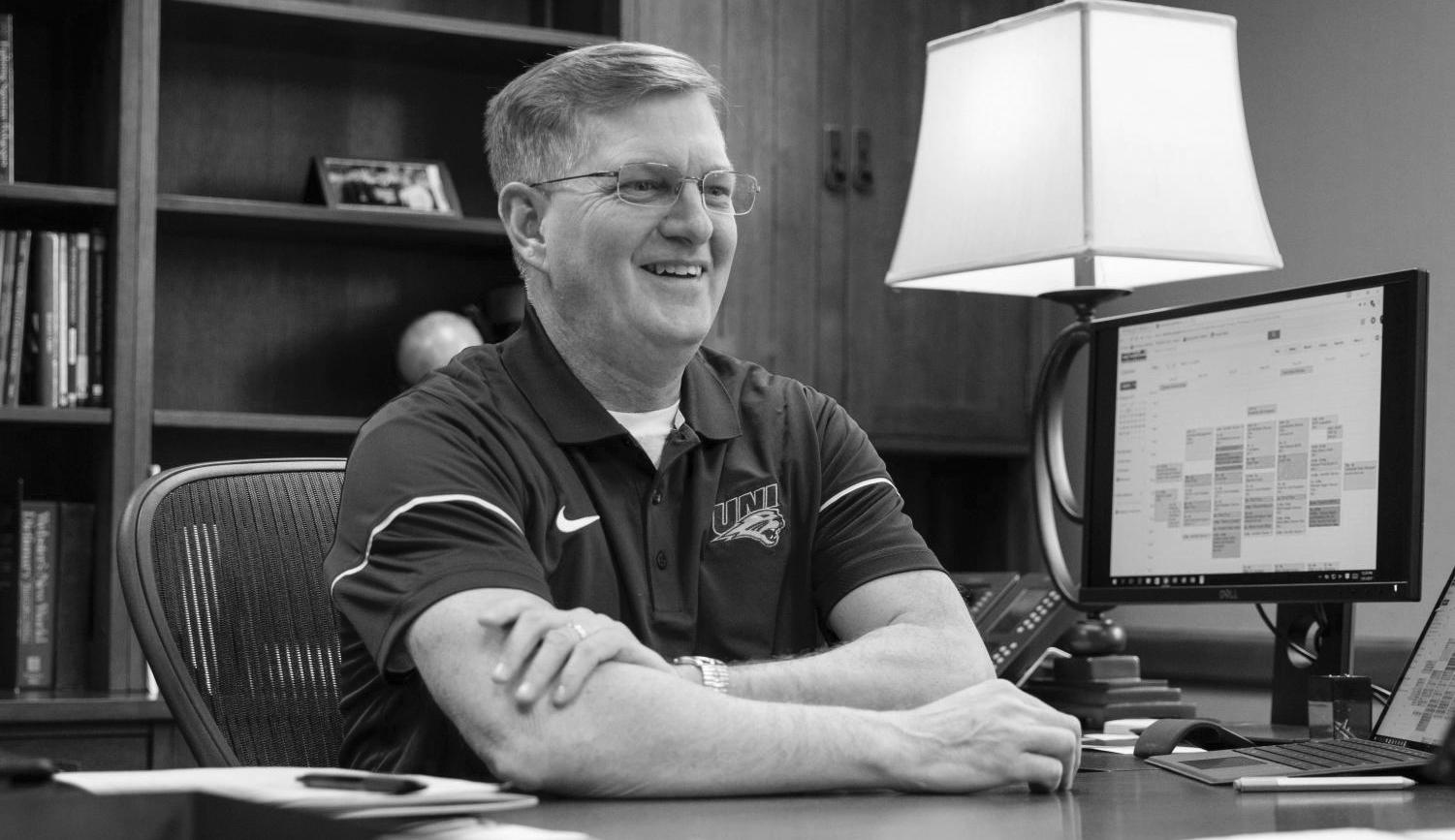
NI ARCHIVES
El Presidente Mark Nook se reunió con la Editora Ejecutiva de Northern Iowan, Bailey Klinkhammer, para discutir el futuro de UNI, abordando los
recientes en DEI y el nuevo programa de enfermería.
“Una de las cosas que ya está yendo muy bien es la campaña Our Tomorrow, para recaudar fondos para apoyar a los estudiantes, al profesorado y al personal. Espero que durante este año alcancemos nuestro objetivo de $300 millones aproximadamente con un año de antelación, y continuemos superando esa meta. Pero este año, alcanzar realmente ese objetivo será algo grande por lo que significa para apoyar a nuestros estudiantes y profesores, y podremos aumentar las oportunidades educativas para los estudiantes. De eso se trata esta campaña. Además de eso, hay muchas cosas emocionantes sucediendo a nivel local y nacional, especialmente con la elección presidencial que está en marcha. Siempre espero trabajar directamente con NISG y con Lizbeth Montalvo este año como presidenta del cuerpo estudiantil. Ambos estamos emocionados, ya sabes, averiguando a dónde quieren ir con algunas cosas estudiantiles, o entendiendo lo que estamos tratando de hacer como universidad, y trabajando juntos para que eso suceda.”
Revisando su entrevista con Caroline Christensen, la ex Editora Ejecutiva de Northern Iowan, usted habló sobre cómo el nuevo programa de enfermería y el
edificio de ingeniería aplicada estaban en proceso. Un año después, ¿en qué estado se encuentran esos proyectos hoy?
“Bueno, mirando hacia atrás un año después, esos proyectos están comenzando a dar frutos. Estamos dando la bienvenida a nuestra primera cohorte de estudiantes de enfermería en las nuevas instalaciónes. También estamos recibiendo a nuestros primeros estudiantes en el programa de ingeniería de Ciencias de Materiales, y esas instalaciones que mencionaste son importantes. Realmente es fenomenal lo que la oficina de instalaciones han podido hacer para diseñar ese espacio y hacerlo funcionar, traer todo el equipo desde las camas hasta los aparatos y los maniquíes, realmente ha sido increíble de ver.”
Con la reestructuración de DEI en los campus de los regentes de Iowa, ¿cómo está cambiando DEI en UNI y cómo se está integrando la inclusión en UNI como institución?
“A medida que la junta de regentes lidiaba con esto, como la legislatura estatal luchó con esto, lo único que queríamos como universidad es mantener nuestro compromiso con
nuestros estudiantes, y eso nunca cambiará. Desde hace 149 años, cuando UNI abrió sus puertas, estamos aquí para apoyar a cada estudiante y asegurarnos de que cada estudiante tenga las herramientas que necesita para tener éxito. Tenemos una obligación moral de poder apoyar y ayudar a los y las estudiantes a obtener la educación que necesitan. Nunca nos alejaremos de eso. Ha requerido un tipo de ajuste, y eso es de esperarse. Hemos tenido que reorganizar algunas cosas para estar en línea con lo que se nos exige desde la junta de regentes y la legislatura, pero estamos aseguràndonos de que al final del día, seguimos atendiendo las necesidades de nuestros estudiantes y profesores. Eso es algo que nunca podría cambiar.”
Usted tiene un doctorado en astronomía y es el presidente de una universidad con más programas de los que yo podría contar, ¿qué programas aquí le intrigan a usted? Si pudiera seguir a un estudiante durante un día, ¿qué tipo de programas le gustaría explorar?
“¡Eso es realmente difícil! No sé si podría elegir solo uno. Realmente me encanta ver lo que hace el programa de teatro cada año. Sería muy divertido asistir a un par de esas clases. Me encantaría ver
lo que hacen los estudiantes de música también, asistir a esas clases. El programa de gerontología, especialmente con la casa de simulación de demencia, eso sería muy genial de ver también. Hay tantos programas aquí que son tan interesantes, pero habiendo pasado mi propio tiempo como estudiante estudiando ciencias, me encantaría ver los diferentes programas de arte.”
¿Cuál es un consejo que desearía poder dar a cada estudiante cuando se gradúa de UNI?
“Probablemente cambia cada vez que alguien me lo pregunta, pero creo una de las cosas que me gustaría decirle a todo el mundo, y una cosa que les digo a mis hijos, es que dediquen un tiempo real a pensar en la inversión que quieren hacer con su vida. Tienen la educación que necesitan para avanzar en una carrera. Tienen un tiempo relativamente corto aquí, ¿cómo quieren usar ese tiempo para invertir en ustedes mismos y en los demás? ¿Qué parte para su carrera, qué parte para su familia, qué parte para su comunidad? Cuáles son las cosas que son importantes para ustedes, y luego descubran su propósito; y su propósito puede cambiar, pero establezcan una brújula moral fuerte. ¿Cuál es su Estrella Polar?”


BAILEY KLINKHAMMER Executive Editor
As of 2024, most students who attend the University of Northern Iowa were born during or after 2001, meaning that most students were no older than three or four years old when Hurricane Katrina devastated the gulf coast. Most students don’t have memories of the natural disaster beyond the clip of Kanye West on national television saying “George Bush doesn’t care about Black people,” and the pictures of New Orleanians trapped on their roofs waiting to be rescued. On this year’s 19th anniversary of the devastation, Spike Lee’s documentaries “When the Levees Broke” and “If God is Willing and Da Creek Don’t Rise” still offer a valuable perspective on how federal mistakes can lead to death and devastation.
One of the most common misconceptions about Hurricane Katrina and its
effects on New Orleans is that the flooding cAme from Hurricane Katrina itself. The flooding came from over 50 levees surrounding New Orleans failing while the hurricane passed New Orleans, leading Lake Borgne and Lake Pontchartrain to flood New Orleans. For days, New Orleanians were stranded in the flooded city without food or water in the brutal heat and humidity. People were trapped in their houses, in the New Orleans Superdome and the Convention Center. In Lee’s “When the Levees Broke,” it’s detailed just how horrific the environment was. Bodies floating in the flooded street, looting due to a lack of clean water and food, and people trapped on their roofs writing SOS and waving flags at passing helicopters.
“When the Levees Broke” was a documentary made in an effort to elaborate on what actually happened in New Orleans
during Hurricane Katrina.
“If God is Willing and Da Creek Don’t Rise” is a follow-up documentary made five years later on how New Orleans continues to cope with the natural disaster. “When the Levees Broke” lends itself to those who know nothing about Hurricane Katrina as a textbook on how not to navigate a flood that devastated and misplaced thousands of Americans along the gulf. The documentary crafts a narrative that’s hard to digest as it’s the reality of the situation. The gravity of that is one that’s hard to swallow. What Lee does in “When the Levees Broke” is deliver the hard truth, one of failure from the federal government, from the Corps of Engineers, and from the Federal Emergency Management Agency (FEMA). Lee allows the interviews to be the narration of a documentary, using footage captured from the dev -
astation as a backdrop to the survivors’ stories. Lee illustrates through a compilation of interviews that these failures cost people their lives, their homes and their families.
“If God is Willing and Da Creek Don’t Rise” was crafted as a follow-up on the people Lee had interviewed five years prior in “When the Levees Broke.” It discusses the lack of resources given to New Orleanians, and how those displaced after Katrina yearn to go back to their home city. Most of the displaced New Orleanians discuss how that’s entirely impossible for them now, although they wish it wasn’t. Some simply bid New Orleans goodbye, and say they could never trust a city that wouldn’t protect them in their time of need. “If God is Willing and Da Creek Don’t Rise” captures this spectrum of emotion alongside the red tape and lack of resources that are provided to New
Orleanians still struggling to rebuild five years after Hurricane Katrina.
For those unfamiliar with the devastation brought upon New Orleans because of Hurricane Katrina, both “When the Levees Broke” and “If God is Willing and Da Creek Don’t Rise” provide valuable insight into arguably one of the worst natural disasters that have ever happened in America. 19 years after the disaster, Lee’s “When the Levees Broke” and “If God is Willing and Da Creek Don’t Rise” still provide a lens like no other into the world of New Orleanians and the devastation that occurred not just because of Hurricane Katrina, but because of a multitude of failures and mistakes. Both documentaries are available to stream on HBO’s Max.
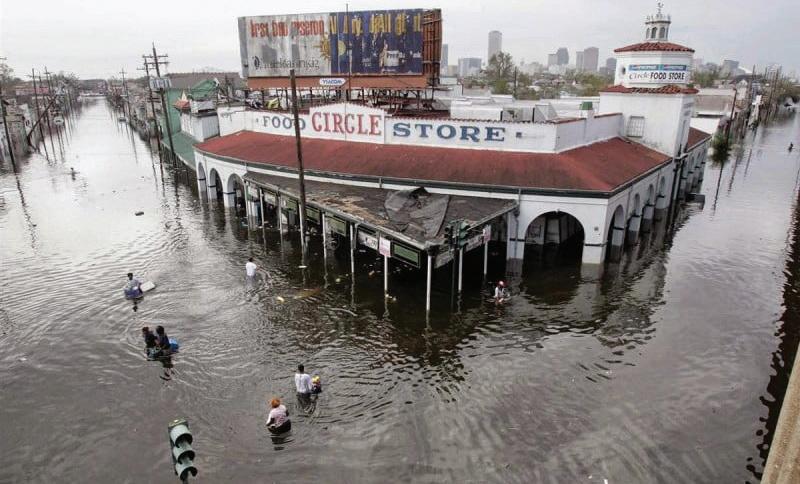

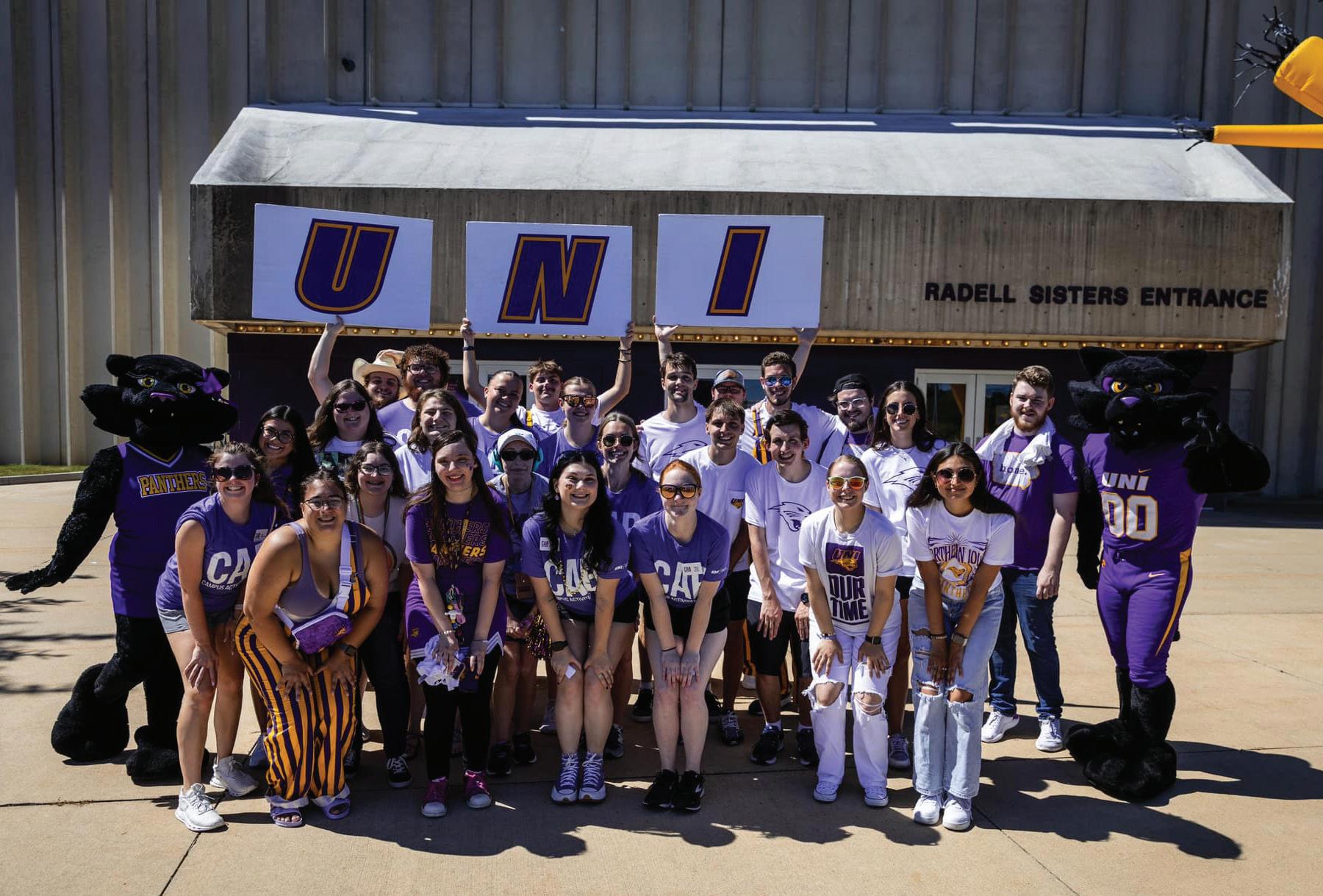
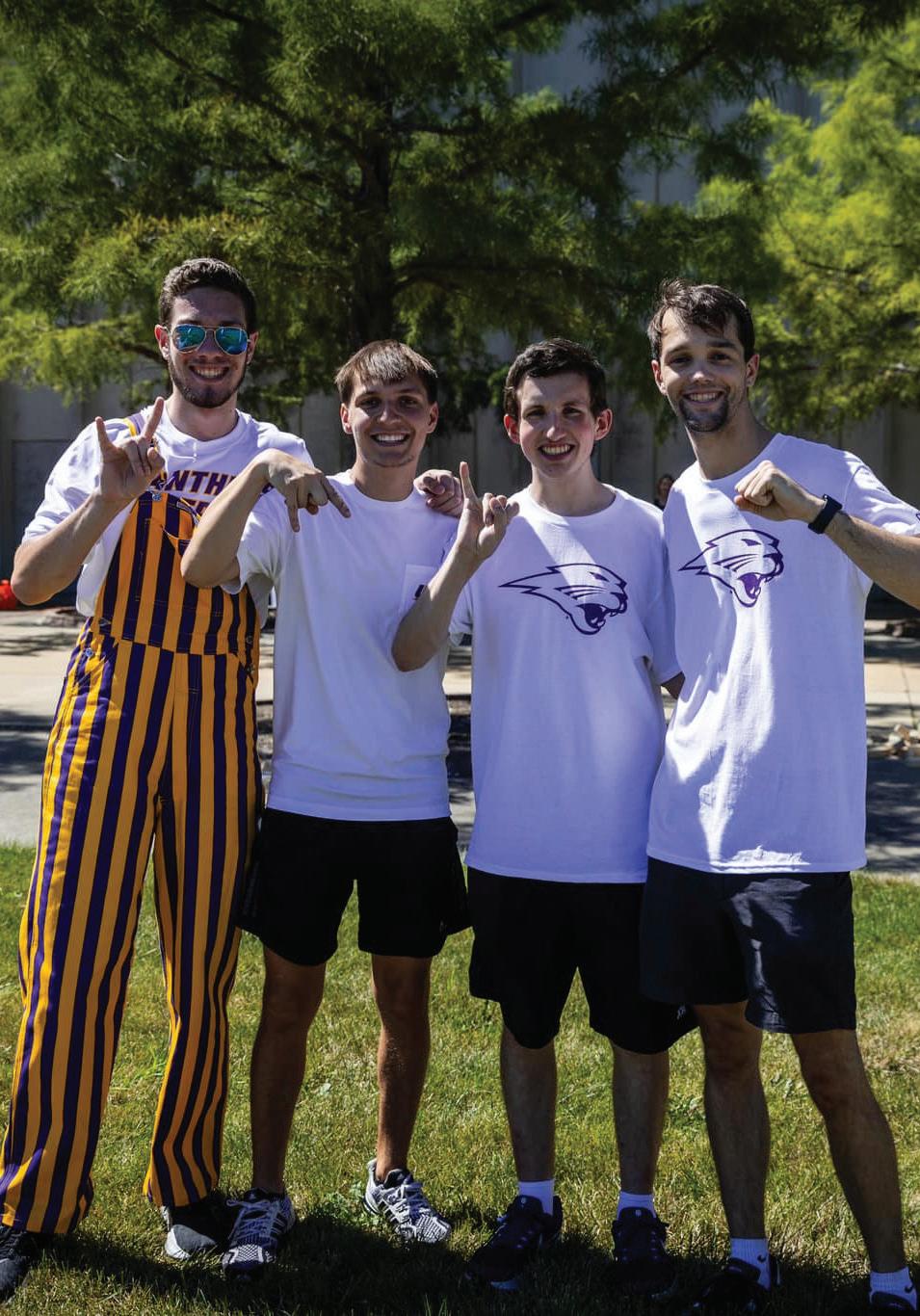
SORORITY
continued from page 3
Truly, my UNI experience wouldn’t be the same without it and I can say that completely honestly.”
Primary recruitment for this academic year starts Sept. 11. There are three ways for students who are wanting to join to reach out and get enrolled. They
can go to either @UNIFSL or @UNISororityLife on Instagram or they can go online to https://union.uni. edu/involvement/fsl. All of these online resources have a link to a sign up form where students can sign up to get involved in primary recruitment.

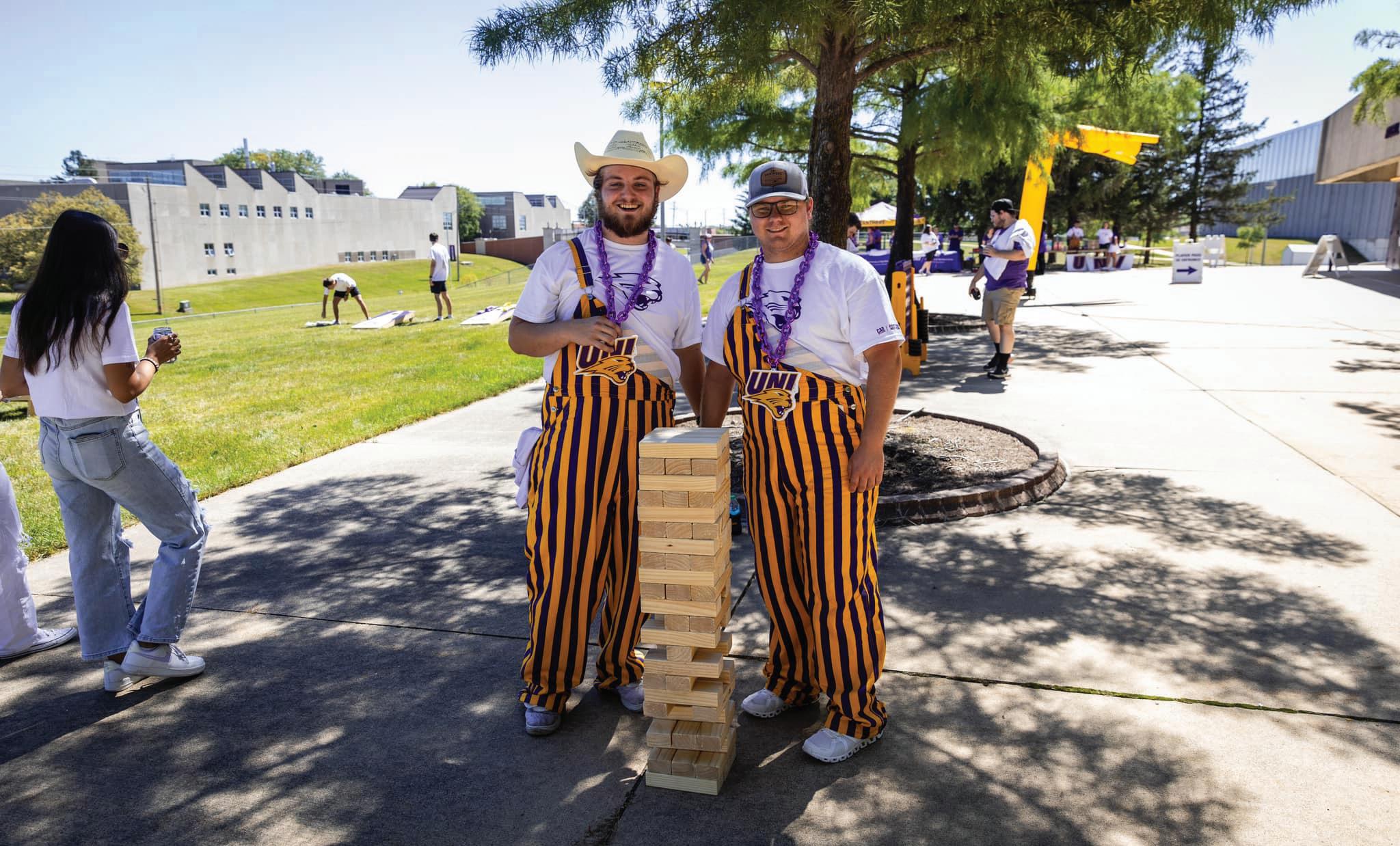

Harms’ final piece of advice to anybody thinking of joining but on the fence about making the leap is, “Just do it. I think a lot of times it’s scary and you just are worried that it’s not for you but I would just recommend trying it, because ultimately sorority life is
for everyone. That is something that we have worked so hard to push here UNI. We want you to thrive with people that are going to push you to be your best and that’s what I’ve gotten out of this. I’m leaving UNI just feeling so proud of the community. I think take the
chance, go through recruitment and you’re going see the results going forward. I’m leaving UNI with just so much love for not only the university but the entire community so I wouldn’t change it for the world, I’m just really proud of us and what we’ve done.”

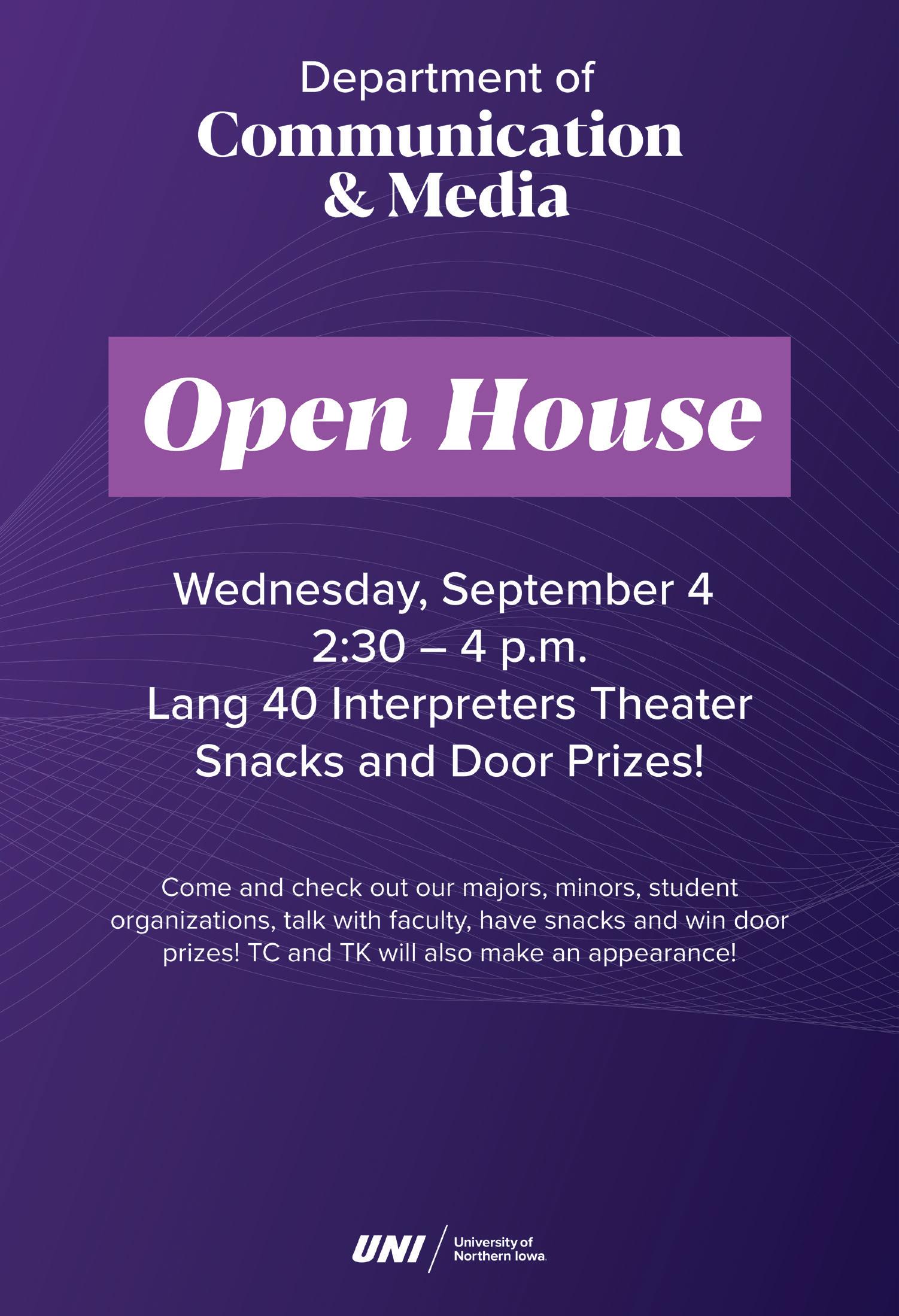
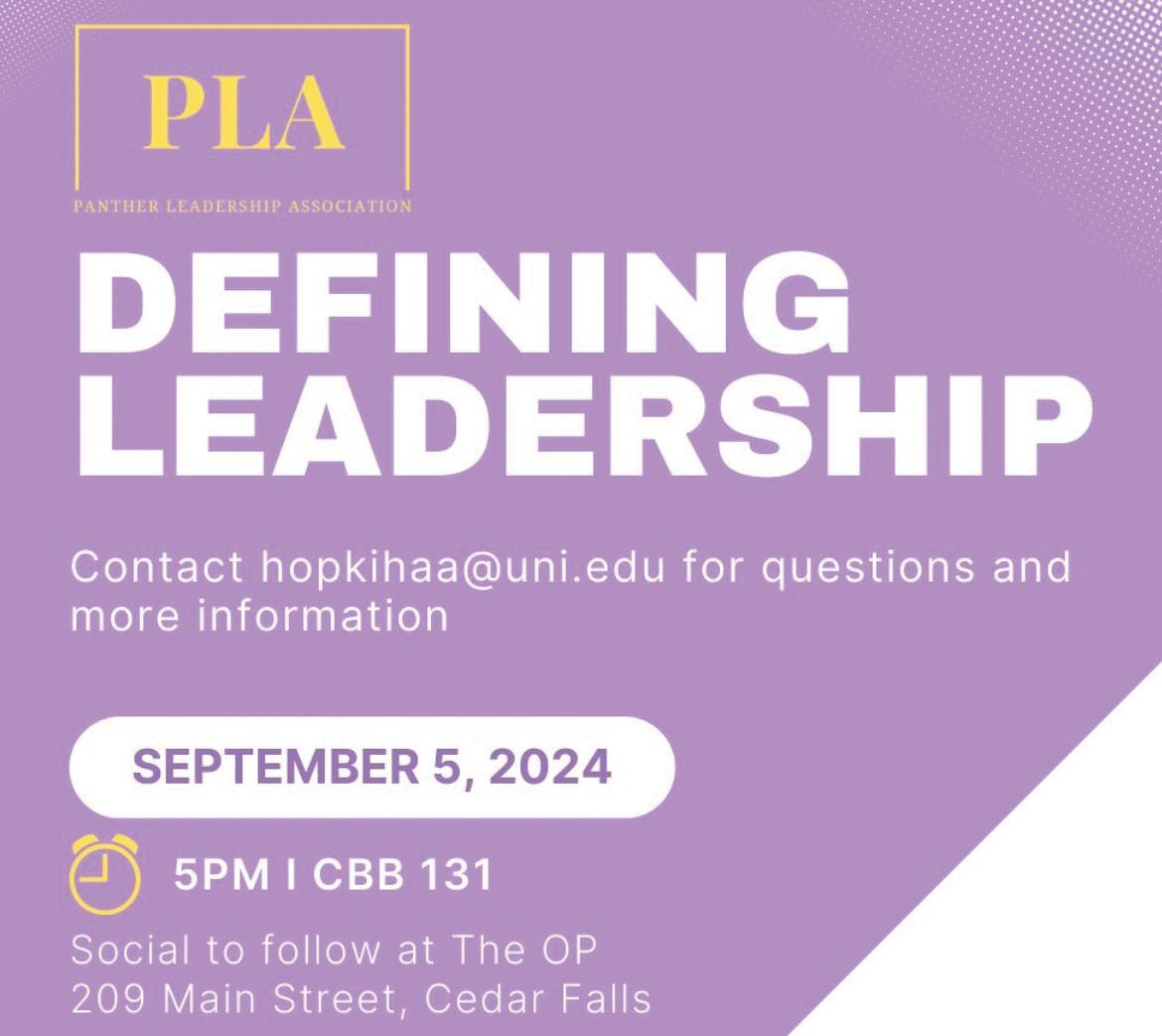



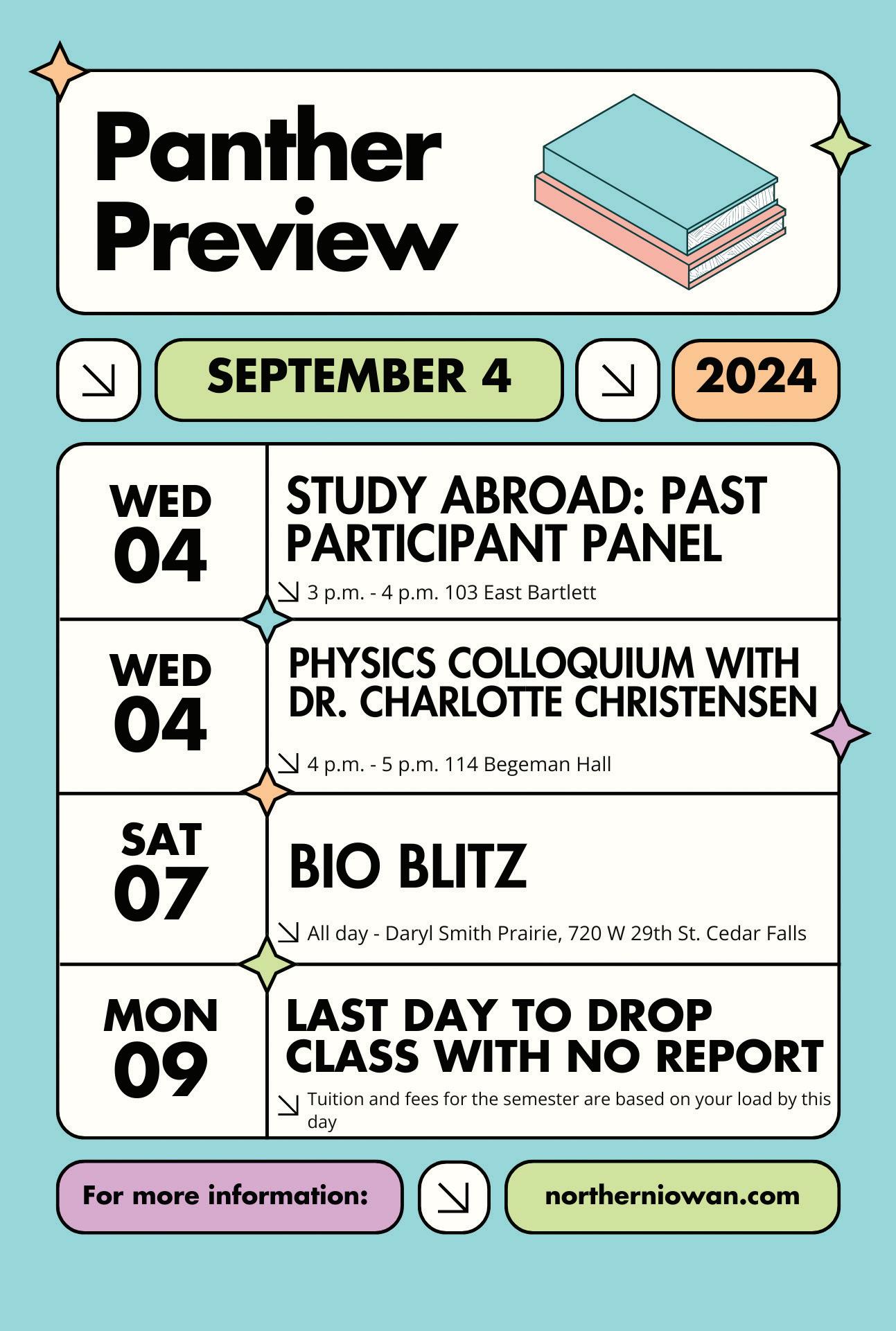

MICHAEL SPAHN Sports Writer
A warm fall Saturday afternoon on the final day of August came the season opener for the Northern Iowa Football team. The Panthers won dominantly 35-7 against the Valparaiso Beacons.
The Panther offense got off to a hot start to the season. New starting quarterback Aidan Dunne found Jaiden Ellis-Lahey for a gain of 12 and followed it with a first down completion to Desmond Hutson for three yards. Dunne finished the drive going four for four passing, capping it off with a 21-yard touchdown pass to Layne Pryor to make it 7-0 Panthers early.
“It was great to get off to a fast start,” Dunne said postgame. “The big guys up front were moving people and I had plenty of time to find open guys.”
The Panther offense went right back to work after a quick defensive stop. Tye Edwards and Amauri PesekHickson got the running game going as both players rushed for first downs. Dunne continued to hit open receiver Tysen Kershaw for a gain of seven yards. The offense got creative in the red area with a screen pass for PesekHickson, who ran 20 yards for a touchdown. The Panthers extended their lead to 14-0 against the Beacons near the end of the first quarter.
The Panther defense continued to shut down the
Beacons with back-to-back sacks to start the drive. Carter Hewit got to the quarterback on first down for a loss of eight yards followed by Zach Mehmert and Cannon Butler getting home for a loss of four.
On the first play of the second quarter, Panthers running back Tye Edwards broke away from the defense for a 54-yard touchdown run to extend the Panthers lead to 21-0.
The Beacon’s offense finally got the big play they were looking for, completing a 61-yard pass down to the Panthers 12-yard line. The drive ended with a Beacons 1-yard rushing touchdown to cut the lead to 21-7 Panthers.
After both teams traded three-and-outs, The Panthers returned to relying on the run game. Edwards started the drive with two carries for a gain of nine yards. Dunne got in the mix with a 10-yard keeper to the Beacons 35-yard line. The Panthers returned to Edwards near the red area as he rushed for an 11-yard gain. On the following play, Edwards capped off the drive with a 12-yard touchdown. The Panthers extended their lead to 28-7 near the end of the second quarter.
After a quick three-andout for the Beacons, Edwards continued his dominance on the ground with a 49-yard rush down to the 22-yard line. A few plays later, Dunne found Lane Pryor for a gain of 17 down to the 5-yard line. Facing a third down-and-five from the red zone, Dunne
found Sergio Morancy in the corner of the endzone for a touchdown. The Panthers extended their lead to 35-7 early in the third quarter. The offense got the ball back quickly and hammered the running game. Harrison Bey-Buie rushed eight times for 33 yards, setting up the Panthers near the red zone.
The Beacon’s defense stalled the Panther offense, which led to a 31-yard field goal attempt by Caden Palmer, which was no good.
After forcing the Beacons to punt for the eighth time, The Panthers got the ball back on offense and continued to milk the clock late into the fourth quarter. Backup quarterback Matthew Schecklman saw his first action of the season, while Bey-Buie continued to be effective on the ground with 38 yards on the final drive. The Panthers ran the clock out to secure the victory.
The Panthers start the season 1-0 for the first time since 2016. This was their first time opening the season at home since 2010. “It’s been so long I forgot,” coach Mark Farley added after the game. “There’s a confidence you get from walking out in the Dome the first game versus fourteen years in a row walking out in someone else’s stadium.”
The Panthers will look to start 2-0 as they travel to St. Paul, Minnesota to take on the St. Thomas Tommies on Saturday.
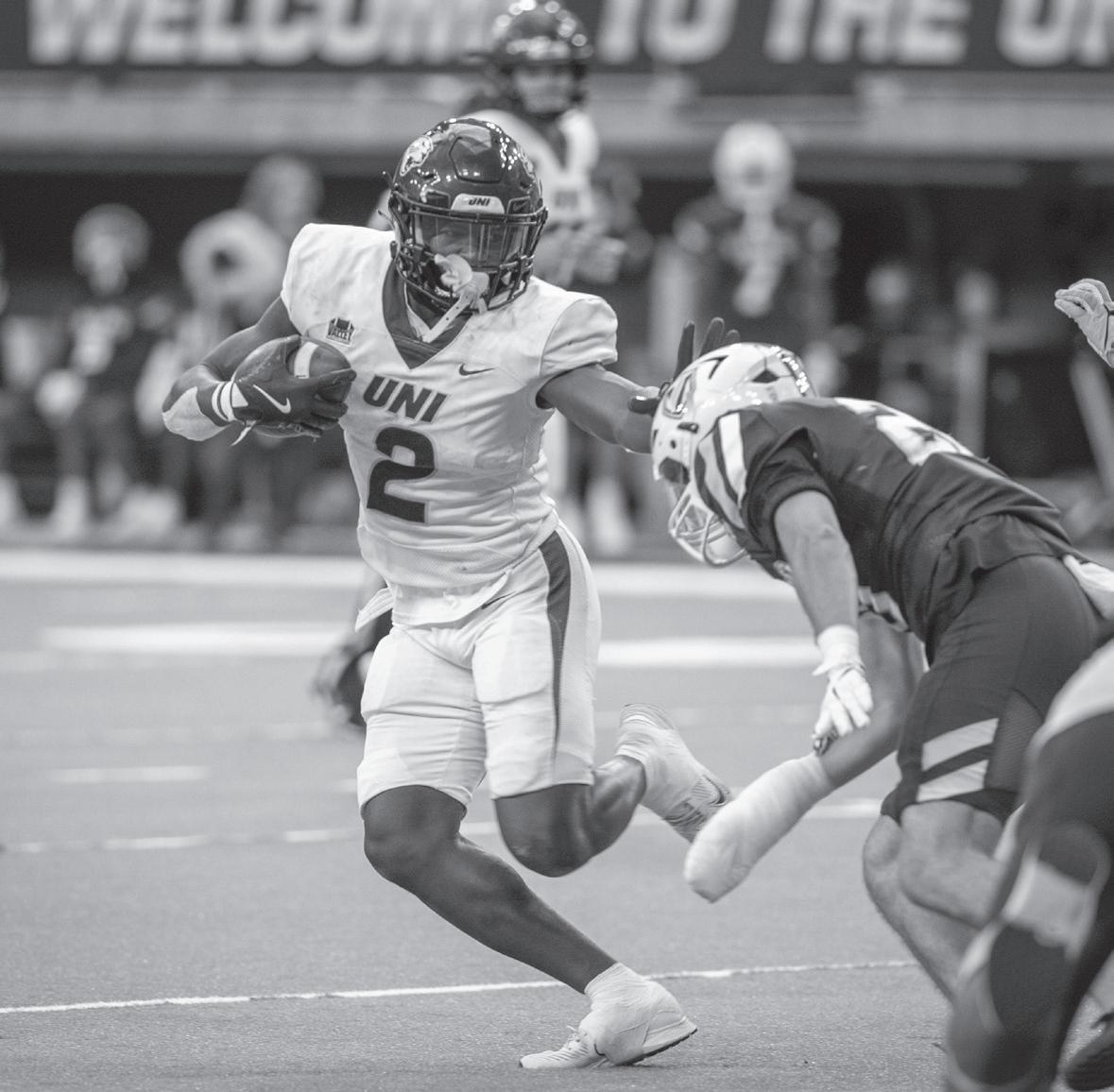
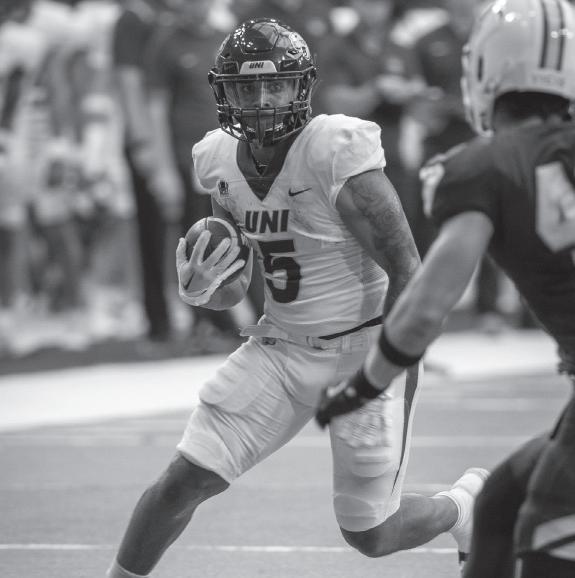
ADAM JOHNSON Sports Writer
The new college football season went into full swing this past weekend, but things looked a lot different from last year. A plethora of teams joined new conferences, and most of it came from the cessation of the Pac-12.
Last season the Pac-12 featured 12 football teams that all had to find new homes for this season. One of those landing spots was the Big Ten, a conference whose namesake makes even less sense now that there are 18 teams in it. The University of Southern California, UCLA, Washington and Oregon all joined the conference. This was a big move for the Big Ten, as these teams represented the best of the Pac-12
for the most part in football.
The Big 12 was another conference that added four of the former Pac-12 teams. They added Arizona, Arizona State, Utah and Colorado. Nice additions to a conference that lost their two biggest powerhouses of Oklahoma and Texas to the SEC. While the top might not be as good without those two, the conference could have more balance than we have seen in the past.
The other conference that took in Pac-12 teams is the ACC. Seemingly not a very good fit, being that the ACC is on the Atlantic coast. Stanford and California will have a lot of long trips ahead of them.
The last two teams from the Pac-12 are Washington State and Oregon State, who
were unable to make their way into any of the top conferences. They are both playing a Mountain-West schedule this year, which could be detrimental to their programs. They definitely got the short end of the stick compared to their Pac-12 counterparts.
The Pac-12 was the biggest change to this year’s season, but other teams have been moving around conferences as well. With the Pac12 being eliminated, it now leaves a power four instead of what was called the power five conferences. While these changes are substantial, this could only be the beginning of an even larger shift in conference realignment in the future.
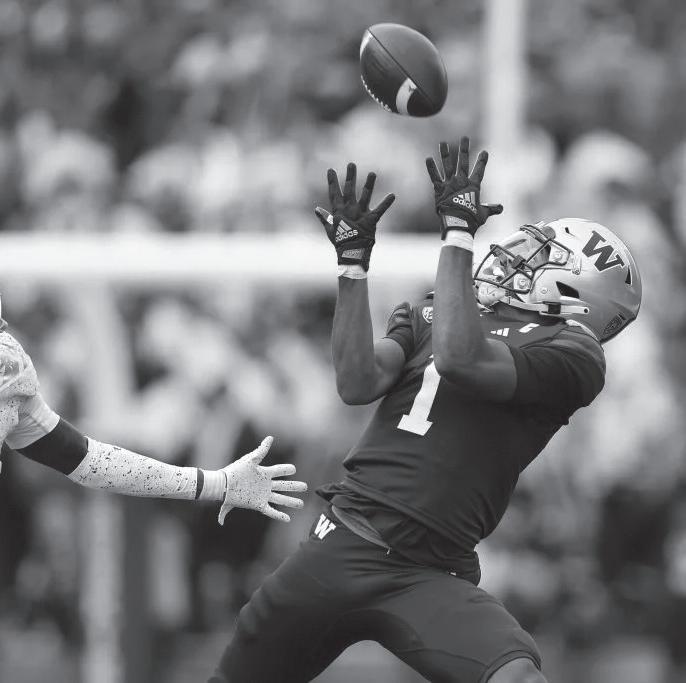

NICOLE WATERS Sports Writer
The Panthers started off strong in the opening set, never losing the lead. They jumped to a quick 9-3 lead thanks to errors by FIU. Kaitlyn Sellner and Olivia Tjernagel both had four kills in the first set as part of a 16-kill set for the Panthers. Along with a pair of aces from Kira Fallert the Panthers would go on to be dominant in the first set winning 25-12.
Fallert started off with another pair of aces and Erin Powers followed behind with one as well to keep the Panthers momentum rolling. They put together an early lead of 7-1 thanks to a 6-0 run as well as eight more after that to boost the lead to 15-4. The momentum kept going to allow Grace Mikota and Lily Dykstra an opportunity to come off the bench and help the team to a 25-11 second set win.
Another set of backto-back aces from Fallert helped boost the Panthers early to a 3-1 lead in the third stanza. FIU would then try to find their groove and rally back against the Panthers, but Cassidy Hartman would prove to be too much for them and tie up the set 11-11 with a kill. UNI would continue to go on to keep the lead and score the last seven of 10 points to take the set 25-20 and sweep FIU.
The Panthers then battled the Dayton Flyers next in their matchup. UNI was back-and-forth early in the first set as Kacie Rewerts captured three early blocks for the Panthers. Hartman tallied six kills in the first set and Fallert followed behind with four to help the Panthers rally ahead to a 15-11 score. Dayton came back to tie it up 15-15 and at 20-20 but UNI would reign supreme and secure the set with a 25-20 win.
UNI grabbed the lead
early with a 4-1 score, but it was not enough as the Flyers would come out hot. Dayton had seven blocks in the second set and forced the Panthers to nine errors. The Flyers closed out the set on a 5-1 run and captured the set in a 25-21 set win.
The Panthers found their groove again in the third set posting a team 18 kills to keep momentum during the set. UNI led the whole match thanks to a solid defense from the team which helped out Fallert and Hartman in the front row. They ended on a 7-2 run and captured the set 25-15 going up 2-1.
Dayton came out strong in the fourth set breaking an early 9-9 tie from the Panthers. They would continue to rally on and gain a 16-7 run to close the frame.
The Flyers held UNI to a .143 hitting percentage while they tallied 14 kills in the set and forced a fifth set between the two.
The Flyers momentum
from the fourth set continued on into the fifth. Dayton went on a 7-2 run, as well as a nine-kill set with only one error. The Panthers would do their best to battle back, but ultimately ended short with a 15-11 loss in the fifth set and the match going to the Flyers.
To round out the weekend the Panthers battled a tough Ohio State team. Ohio State started off strong on the first set posting 13 kills and making times difficult for the Panthers. UNI fell behind 15-8 but rallied back on a 6-0 run to get within one. The Buckeyes proved to be a service powerhouse in the first set against the Panthers and closed out the set 25-20 resulting in a Panther loss.
On the flip side, the Panthers came out hot in the second set and never let up. They gained a 5-0 runmidway through the set to help keep momentum pushing and build a nine-point lead during the set.
The Buckeyes would come back within one at 22-21 but the Pantherswould hold off and take the set 25-22. The third set was extremely back-and-forth between the two teams giving it their all, with 13 ties and five lead changes. Sellner and Fallert helped to keep the Panthers alive in the set as the team had 15 kills to build a 24-21 lead. Despite their efforts, the Buckeyes would make their way back and go on a 5-0 to close out the set and take it from the Panthers in a 26-24 win, forcing a fourth set.
The fourth set proved to be a lot of back-and-forth between the two teams with Ohio State leading for most of the set. UNI totaled 20 kills in the final set which challenged the Buckeyes late. The Panthers would have set points in their favor twice, but Ohio State would rally late and take the fourth set victory on some Panther errors 29-27.
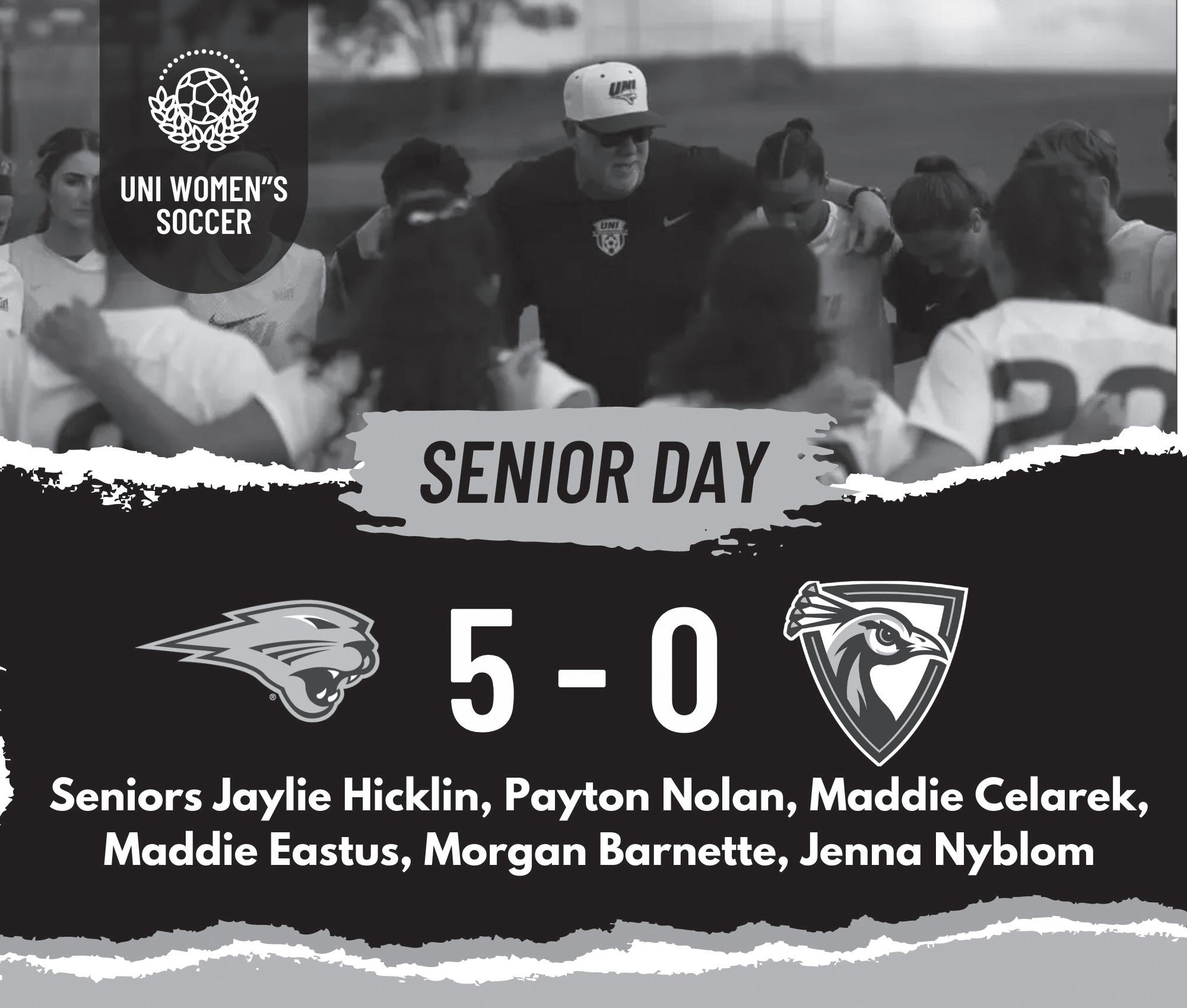


NI STAFF
UNI Swimming and Diving’s own Olivia Chambers captured gold in Paris in the women’s S13 400-meter freestyle with a time of 4:29:93, and silver in swimmer competing in the ten-athlete event seeded with the world’s fastest time this year and second-fastest overall in the field, Chambers opened the day with a dominating performance in the first of two preliminary heats
Beltran, from Spain by 17.83 seconds. Shokhsanamkhon Toshpulatova of Uzbekistan finished third in the heat with a time of 4:52.14. In the second prelim heat, reigning world champion Carlotta Gilli of Italy came in first
CHAMBERS IS THE FIRST ... PARALYMPIC MEDALIST FROM UNI

GOLD MEDAL FROM UNI SINCE 1952
DUAL MEDALIST FROM UNI
SWIMMING MEDALIST FROM UNI
Chambers repeated her impressive preliminary performance in the finals by shaving 2.62 seconds off her career-best time from last summer’s Para Swimming World Championships in Manchester, England, a race in which she finished second.
Leading from start to finish, she held off Gilli by 1.90 sec -
onds, who earned the silver medal, while Stetsenko won bronze with a time of 4:36.17. Chambers placed 5th in her third event, the S13 50m freestyle final with a time of 27.65.
On Tuesday, Sept. 3, Chambers brought home silver in the women’s SM13 200-meter medley with a time of 2:25.90. Gilli of Italy finished first with a time of 2:25.33, less than 60 milliseconds before Chambers. Róisín Ní Ríain of Ireland came in third with a time of 2:27.47. Other Americans in the SM13 200-meter medley were Grace Nuhfer with a time of 2:32.82 and Colleen Young with a time of 2:34.95, who placed sixth and seventh respectively. Chambers continues to compete in the Paralympics on Sept. 4 and 5, competing in the Mixed 4x100 Freestyle Relay, pending the direct final, and the SB13 100m Breaststroke. which will both be streamed live on Peacock.
COURTESY
Olivia Chambers, a 21 year-old student from UNI becomes UNI’s first paralympic medalist. She captured gold in her 400m freestyle race, and became UNI’s first every dual medalist as she captured silver in her 200m Individual Medley race. Chambers continues to swim later this week.

